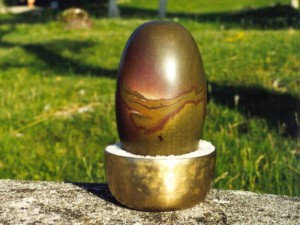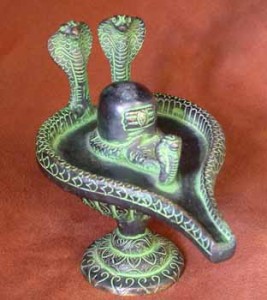
Shiva Lingam
By Julian Millane
Shiva Lingam is part of a series on Indian Spiritual Mythology on this site.
The most common object of devotion in Shiva shrines is the Shiva lingam. Its origins can be traced to primitive stone symbols as far back as the neolithic period. Symbols such as these can be seen at pre-Aryan sites at Mohenjodaro and Harappa.
The lingam denotes the male creative energy of Shiva – the fixed or immovable qualities (dhruva) or the fundamental form (mulavighara).
The shiva lingam is often combined with the primary symbol of female creative energy, the yoni, the latter forming the base of the image with the former rising from its centre.
This serves as representation of the creative union that procreates and sustains the life of the universe. Lingam and yoni, Shiva and his goddess Shakti, symbolise the antagonistic yet co-operating forces of the sexes.
The origin of the Shiva lingam
The myth of “The Origin of The Lingam” (lingobhava) opens with the primeval situation – no universe, only water and the starless night of the lifeless interval between dissolution and creation – all the seeds of subsequent evolution rest dormant.
Vishnu is floating upon the substance of his own essence, the fluid of life – radiant with the steady glow of his blessed energy.
But suddenly Vishnu perceives another luminous apparition, approaching him with the swiftness of light and the brilliance of a galaxy of suns. It is Brahma the creator of the universe, the four-headed one, full of yogic wisdom.
He inquires of the recumbent Vishnu, “Who are you and how did you originate, for I am the progenitor of all beings. I am He who originated from Himself”.
Vishnu protested, ”On the contrary, I am the creator and destroyer of the universe.”
The two mighty presences contested each others claims and quarrelled, and while they were arguing in the timeless void, they perceived rising out of the ocean a towering lingam crowned with flame. Rapidly it grew into infinite space.
The two divinities ceased arguing and regarded it with amazement. They could measure neither its height nor its depth.
Brahma said, “You plunge and I will fly upward. Let us try to discover its ends.”
The two assumed their animal forms, Brahma, the gander and Vishnu the boar, and raced in opposite directions in search of the limits of the Shiva lingam. But the lingam grew and grew.
Presently the side of the prodigious phallus burst open, and in the niche-like aperture the lord of the lingam stood revealed, Shiva, the force supreme of the universe.
While Brahma and Vishnu bowed before him he proclaimed himself to be the origin of them both. Indeed he announced himself as the triad, Brahma, Vishnu and Shiva – Creator, Preserver and Destroyer he at once contained and embodied forth.
Though emanating from the lingam they abode permanently within it. They were parts of it, constituents, Brahma the right side and Vishnu the left. But the centre was Shiva-hara, “The Re-absorber, He who takes back or takes away.”
Thus Shiva appears augmented in the lingam, heightened, enhanced as the all-comprising basic element.
The Lingam and the Yoni
In households and temples the lingam is represented sitting in the Yoni. In stone and bronze it appears as Shiva/ Shakti, the god and the goddess, the male passive aspect of the divine which we know as eternity, the female as the activating energy or shakti, the dynamism of Time.
Though they are apparently opposites, they are in essence one.
The mystery of their identity is stated here in symbol. The god is he whom we have beheld threefold in the “root-figure” of the lingam.
The goddess is the yoni, mother-womb of the ever-cycling eons, of all the universes endlessly extending in space, of every atom in the living cell.
The Lingam is the principal object of worship in Shiva temples such as Elephanta and is very obvious at the tantra temples of Khajuraho.
There, the exterior of the temples are covered in erotic and sensual statues of every possible description, but in the core of the temple in a dark cave is a solitary stone lingam.
During Shivatri, celebrating the birth of Shiva, followers come to bathe the Lingam with milk and water, and offer fruit and flowers to this powerful symbol of the great God. In homes this ritual is repeated daily as a devotional practice.
Shiva lingams are often seen adorned with serpents, which symbolise water, fertility and are associated with Vishnu.
Originally published in the Here & Now magazine, Byron Bay.
Ed Note. These stones, the Lingams, recognisable by their shape and almost ‘made’ feel, are found worldwide, having been taken from India by travellers over the centuries. I found one in the garden of my house in country Australia. They are seen as some kind of ‘grounding’ element.
Share Shiva Lingam with your friends on Facebook

Leave a Reply